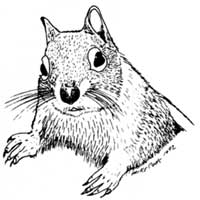A Natural History of My Refugium: Seven Summers in Crater Lake National Park (1)
It was 6 a.m. and cloudy on the gray spring morning when we flew from Ashland’s airport in a small four-passenger plane. We rose above the clouds at 5,000 feet and in short order headed east into the breaking dawn. The sky grew lighter and ever so colorful as the sun began to rise. Within a half hour I could see the gray stillness of Crater Lake as the dawn’s light bounced down the caldera walls. I always knew Wizard Island was supposed to be a nearly perfect cinder cone, but as we circled high above the lake, we were able to see just how perfectly it was shaped because the snow traces radiated down along its slopes, just like the spokes of a wheel. By 7:00 we landed back in Ashland, where the town was just awakening to another gray, dreary morning. But we were not drowsy and feeling under a burden of dark clouds, having just experienced a sunrise flight over Crater Lake!
 Golden mantled ground squirrel. Drawing by Mike Cook, 1992. |
I enjoyed many days hiking and camping during my employment at the park. We discovered many differing habitats, and even climbed Mount Thielson, the peak that towers over Diamond Lake. Though we came to expect golden mantled ground squirrels (Citellus lateralis) along the rim of Crater Lake,2 we were surprised to see one at the very top of Thielson, begging for a handout!
Anywhere I went within the park, I would be greeted by some form of wildlife. Once, while walking along the base of a talus slope near Park Headquarters, I came across a doe and her fawn. In their attempt to avoid me, they could not run away because of the big, blocky boulders they had to cross. So they just walked away. One animal often heard, but rarely seen, is the pika(Ochotona princeps). I often heard them along the caldera walls as I hiked down the Cleetwood trail to the lake’s edge. The first one I ever saw was also the only one that I was able to photograph! It is these little lagamorphs that I miss on my treks in Olympic National Park since they never populated the isolated Olympic Peninsula.
I have had the unique opportunity to “talk” with some of the spotted owls (Strix occidentalis caurina) living within the boundaries of Crater Lake National Park. During my first year as a ranger, I read through the preliminary reports of spotted owl surveys conducted in the park in 1976. Since I had been involved with a spotted owl survey for the Forest Service prior to working at Crater Lake, I was eager to help with work in the park. Even though it was late in the summer of 1977, we were able to locate the owls seen the year before and find a couple of new locations. More surveys followed the next year, along with some predictions for where these birds might be found in the future. Not until 1992 were more in depth surveys conducted, but they found owls in the predicted locations!3
One of my favorite places to visit is Anderson Falls. Not many visitors know about it, or how to get there, because there are no formal trails leading to this spectacular feature.4 One can almost melt into the scenery there, where wildflowers wave at your knees. Upon the cliff above these falls are onions (Allium validum) that grow nearly up to your waist! And are they ever tasty…and strong! I admit that I ate a couple, and then progressed to taste those powerful bulbs the rest of that day and even through breakfast the next day!

